09. HARDWARE
WHY SHOULD I USE WOODWORKERS HARDWARE?
The range of door hardware available on the Australian market is so extensive that it challenges even the most experienced hardware specialist. For someone not familiar with hardware, this can often result in hardware purchases that are not suitable for the application. Woodworkers have designed a range of hardware that aesthetically enhance your doors and windows, while providing the security functions you require.
WHAT ARE THE HARDWARE ISSUES I SHOULD CONSIDER?
The first requirement is to hang the joinery (which can mean hinges, rollers, pivots, automation etc.) The next stage is to secure the item (locks, catches, closers, bolts etc.) The third issue is to permit handling and restraint of the item, (handles, cabin hooks, lifts, door knockers, studs, pulls etc) and finally to protect the joinery against water, knocks, noise, insects, intruders etc (door seals, door stops, push plates, retractable screens, security mesh etc).
THAT'S MORE THAN I IMAGINED? IS THERE AN EASY WAY TO MAKE THESE DECISIONS?
Yes. Woodworkers has created hardware kits for people just like you! We have a kit for most applications in a variety of finishes, pre-packaged to supply all common requirements in a discounted kit. Details of the contents of each kit are shown in Woodworkers "Signature" hardware brochure or on our website www.woodworkers.com.au
ARE KITS BETTER VALUE?
Yes. The cost of the kits are 15% less expensive than the individual items they contain. Kits do not contain hinges however as some joinery is pre-hung. Hinges if required need to be ordered separately.
TELL ME ABOUT HINGES? WHAT ARE THE OPTIONS?
All hinges are not the same. If you want a beautifully smooth operation for years to come, then choosing quality hinges is essential. Woodworkers use premium double ball bearing, stainless steel, 3mm thick, butt hinges as standard because they make even very heavy doors feel light. Stainless steel has superior hardness, is highly tarnish resistant and provides extremely long life. They are available in satin silver, gold PVD or black powder coat colour options, made exclusively to Woodworker's specifications. The standard size for most doors is 100 x 75mm. They are also available in 100 x 100, 100 x 125, 100 x 150 and 100 x 200. Wherever possible you should use the shortest hinges that will meet your needs. Large hinges, particularly parliment hinge designs and those over 100 x 125mm are prone to sag over time due to metal fatigue which increases with the weight of the doors. Woodworkers also carries a range of hirline and other specialized hinges where required.
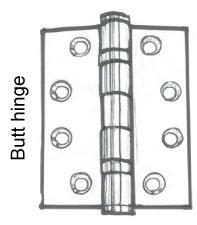
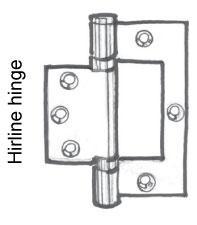
MY CARPENTER WANTS TO USE HIRLINE HINGES. ARE THEY OK?
Yes. Although hirline hinges do not have the life or bearing capacity of butt hinges, they do not have to be recessed into the door or door jamb and are cheaper to buy and quicker to install. They are not as strong as conventional butt hinges so we recommend 3 hinges be used for standard and 4 hinges for overheight doors. Hirline hinges only come in a limited range of sizes. The choice between hirline & butt hinges is often about an aesthetic as well as cost decision.
WHAT ABOUT PIVOT DOORS THAT HAVE NO HINGES?
Pivot or transom closers are a popular idea, especially with large doors where hinges could be problematic. Typically transom closers are used on doors 1200mm wide and handle a door of that size with ease. This is because the door is pivoting top and bottom rather than hanging. The closer is hydraulically controlled which gives a smooth action and the ability to let you set exactly how fast the door closes. Refer our separate FAQ sheet for more information on pivot doors.
WHAT ABOUT DOOR LOCKS. WHAT DO I NEED TO KNOW?
Your insurance company will have more say in your choice of locks than you will. Normally you will not be covered beyond a fixed threshold if you do not have keyed locks on all windows and doors, and this usually requires a deadlock on all doors often with keyed operation on both sides. It is important you ascertain your insurer's requirements before selecting your hardware as requirements vary greatly. Broadly speaking however, locks fall into four categories
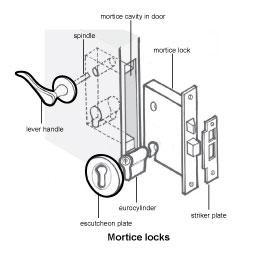
- MORTICE LOCKS are set into a cavity (or mortice) in the door and are the more traditional method of locking quality joinery. They come in a variety of forms for different applications e.g. roller locks for entry doors, parrot beak locks for sliders, latchsets for internal doors and rebate mortice sets for double doors. They require expertise to fit accurately and therefore cost more. They are, however, the neatest and most classic looking of lock options. It is important that you obtain locks that have the correct 'backset' to suit your joinery. The backset is the distance from the edge of the door to the centre of the keyway. Therefore the longer the backset, the further the lock protrudes into the door stile. For normal 110mm or greater stile joinery, 60mm backsets are the best option but with narrower stiles e.g. french doors with 90mm stiles, 45mm backsets may be required.


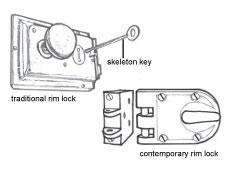
- RIM LOCKS refer to surface mounted locks that are fully exposed on one face of the door. They are less aesthetic than other options but are often cheaper to buy and easier to fit. Rim locks often use a skeleton type key, which provides a poor level of security compared to the pin tumbler cylinders. Some heritage work requires rim locks to match existing or keep the traditional look, but generally rim locks are only used for secondary applications including batwing verandah doors and gates.
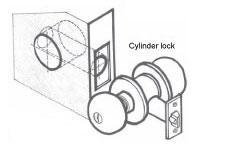
- CYLINDER LOCKS are commonly used in new building work as they are inexpensive and easy to install. They require a single hole drilled front to back through the door with a secondary hole at right angles through to the locking edge of the door to carry the throw latch. Cylinder locks can come with a presentation handle built in but generally have a simple knob or lever both sides. They lack the presentation options available with mortice locks but are the carpenter's favourite for internal work due to their ease of fitting.
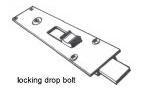
- DROP BOLT LOCKS are fitted at the top and/or bottom of the door and can be keyed, non-keyed or electronically operated. They are either flush fitted, surface mounted or set into internal mortices in the door (called rack bolts). Drop bolt locks only operate from inside and are therefore most useful for non entry joinery (e.g. bifolds, sliders, french doors etc).
WHAT ARE THE INSURANCE REQUIREMENTS FOR LOCKS?
In general, all insurance companies demand higher levels of security when their potential liability increases. They will usually demand a deadlock on all external doors but you need to check whether your own insurer requires a single or double cylinder deadlock. A single cylinder deadlock will allow you to use a turnsnib on the inside for convenience, whereas a double cylinder deadlock will require the inconvenience of keyed operation from both sides. Some insurance companies will allow a single cylinder deadlock and turnsnibs (which is much better for fire escape) provided you have a security alarm system installed. More than 60% of house burglaries occur by entry through windows and therefore most insurers require a key operated lock on every window. If your house does not comply with these requirements you may be unaware that your insurance cover may be negated.
CAN I HAVE THE SAME KEY FOR MY LOCKS?
Yes. We try to key locks alike when requested but sometimes this isn't possible, where, for example, your window keys are different to your door keys. If you are just buying one door and already have locks on other doors, simply supply a sample key and we will advise if we can reconfigure our locks to suit your key at a small additional cost. Other options such as restricted or registered keys (where keys cannot be duplicated) are also available for our locks. Ask our hardware specialists about those requirements.
WHAT PROVIDES THE BEST SECURITY?
Security relates more to the ability of intruders to pick the lock or manually force the lock. Quality locks will be of solid construction and/or have some type of clutch mechanism to resist being manually forced. Older style skeleton keys provide poor level of pick resistance and very limited range of possible key combinations, therefore pin tumbler cylinders are a much better option. Electronically operated locks are another option where security is a primary concern, as well as high security key systems. Discuss your requirements with our specialist hardware staff.
WHAT'S TO KNOW ABOUT DOOR HANDLES?
Door handles are either integral to the locking assembly (e.g. cylinder locks) or completely independent. Most cylinder locks have knobs as standard but in most applications you will strike your knuckles when opening a knob set compared to a lever style handle. Levers keep your hand removed from the door swing and are therefore preferred. With independent handles (used with mortice roller locks) Woodworkers has Australia's largest range of designs with a comprehensive selection of finishes. Most of these handles are unique Woodworkers designs. Door hardware, like a woman's jewellery, allows any door to be individualised and the character of its owners displayed. Always remember there are 2 sides to any door and you may need matching hardware on both sides. Your choice should also consider the projection and position of heavy mouldings on the door to ensure the handles do not clash with the bollection moulds.
WHO FITS THE HARDWARE?
Most non-hanging hardware is fitted on-site by your builder. Where pre-hanging is specified, Woodworkers install the hinges, stays, spiral balances or rollers that are required but do not install locks. This is because even minute variations between the factory positioning and the final installed shape will cause locks to mis-close. If your builder does not want to fit hardware, Woodworkers have independent BSA registered subcontractors who will undertake this work at pre-agreed market rates. It is often a wise idea to install hardware after the painter's work is done, as this avoids having to remove hardware to apply finishes.
WHAT IS THE CORRECT HEIGHT TO FIT LOCKS AND HARDWARE?

Most Woodworkers doors have rails that transverse the door near its centre. These are called 'lockrails' as they are intended for the installation of locks centrally in the rail. The lockrail provides support to the door at its most vulnerable point. In doors where there are no lockrails, the locks are usually positioned at a height of 1000mm or to align with other pre-existing lock heights in the house. Traditionally locks in older houses were between 850 - 900mm above floor level except in the 1930s when heights at approx 1400mm were common.
WHAT SCREWS DO YOU USE?
To completely keep the original and authentic style of traditional joinery and hardware, you may find small details like using traditional slot head screws important. Generally speaking, our traditional hardware may have flat blade screws, while our modern or contemporary range will have Phillips head or Allen key screws.
I LOVE THE LOOK OF POLISHED BRASS BUT WHAT CAN I DO TO STOP IT TARNISHING?
Woodworkers are setting a new standard in the quality of hardware finishes. In the past satin chrome has always been the recommendation for a finish that provides maximum durability and tarnish resistance. Polished brass finishes have a terrible reputation for tarnishing very soon after being fitted but Woodworker's PVD finish (physical vapor deposition), looks like brass but is incredibly hard and durable. High maintenance brass is now a thing of the past. Independent studies have shown PVD to be up to 23 times harder than a satin chrome finish & the PVD process produces no toxic byproducts, unlike old electroplating processes.
WHAT FINISHES ARE AVAILABLE?
Woodworkers carry hardware in 3 finish options although others can be obtained on request. Not all hardware items are available in all non-standard finishes and you should consult our specialist hardware staff if considering non-standard finishes. Our 3 standard finishes are satin silver, gold and black.
- Satin silver has a very durable finish and lends itself to contemporary design. Woodworkers range is generally 304 stainless steel which is rust resistant but can discolour in severe environments e.g. seaside locations. It is always recommended that 304 stainless steel be coated with wax polish, the same as is used on automotive chrome trims to prevent corrosion. This needs to be recoated occasionally as keys and rings tend to remove the protection during daily use. There is also a 316 marine grade range of handles for extreme exposure locations which is more expensive but intensely durable.
- Gold finishes within Woodworkers are either PVD or brass, polished and/or lacquered. PVD is suitable for extreme environments and Woodworkers has the widest range of this high technology finish available. All gold hardware stock products sold by Woodworkers are superior value to anything else available in the market place because we design and control manufacture of our hardware to our own specifications without middlemen and pass the savings to our clients.
- Black finishes are generally powder coat satin black. Woodworkers black range of hardware is unique and is particularly suitable for European style joinery. Powder coat finishes are not durable in corrosive environments (e.g. salt air) and our sales staff should be consulted if you have reservations about your proposed application.
- Other finishes which can be ordered in on request by Woodworkers include bright chrome, florentine bronze and various rust or antique patina options. There is usually a limited range of product available when you venture into the fringe finishes and consultation with our specialist hardware staff is recommended. Woodworkers carries a range of copper, tarnished bronze and rust finishes in certain decorative items e.g. handles, studs, faux hinges etc for particular design applications.
WHAT'S TO KNOW ABOUT DROP BOLTS?
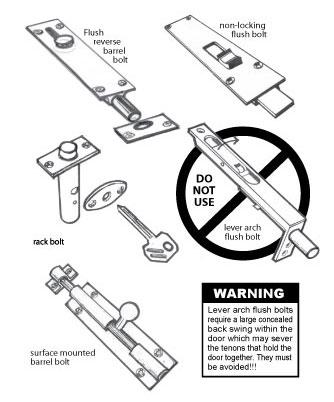
Plenty. There are 3 styles of drop bolts:
Flush bolts
Woodworkers has designed its own range of flush drop bolts that have minimal protrusion into the door. It is essential that drop bolts do not sever the joints within the door causing it to fall apart. Lever arch style flush bolts have a large backswing concealed within the door which causes immense damage to the fabric of the door and cannot be used on mortise & tenon joinery. Woodworkers flush bolts come in both C4 keyway locking format (compatible with some door entry keys) and non-keyed design. Special router bits are available from Woodworkers to neatly fit flush bolts ensuring the intrusion into the door is kept to a minimum
Surface mount bolts
Woodworkers also carry a range of surface mounted barrel bolts for budget applications that perform the same function as the concealed range of bolts but care needs to be exercised with this choice in bi-folding situations where they may interfere with the flat stacking of doors..
Rack bolts
Rack bolts are generally cylinders that fit into the top and bottom end of the door and operated with a key through the inside face. They are simple, inexpensive and unobtrusive. However, as the photos show, they are better suited to solid core doors rather than mortice and tenon construction, as installing the bolt destroys the tenon and weakens the door structure. This can mean that the door is vulnerable to failure if kicked hard.
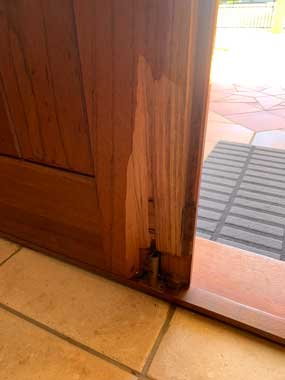
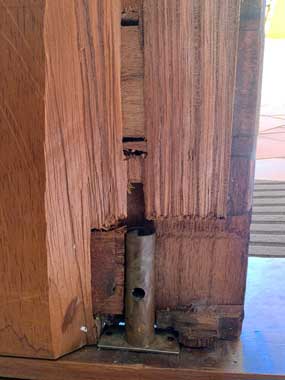
DO I NEED DOOR SEALS?
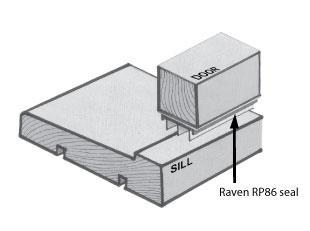
Generally no. If your joinery is supplied with a frame, you will have a sill under the joinery intended to expel water from the building. There is usually a 2 - 3mm gap under the joinery to the top of the sill which is not enough to permit the ingress of water except in the most exposed locations. If you have an exposure problem or if you have opted not to use a timber sill you will need a proprietary door seal to stop water, vermin and insects entering the house. Woodworkers recommend the Raven Seal RP4 or RP86 as being the most effective and trouble free. It is best to avoid 'clever' retracting seals fitted into a groove on the underside of the door as these will require maintenance over time and can weaken the lower joints of the door. If you have heavy exposure you may also need to consider jamb seals around the sides and top of the door integrated into the door stop. They are easy to install during manufacture if our staff are advised of their necessity during the shop drawing process.
IS THE HARDWARE DELIVERED WITH THE JOINERY?
Generally yes, if it has been ordered with the joinery being delivered. It is never a good idea to leave hardware unprotected on building sites and care should be taken to either store it securely or remove it until required. Claims for missing hardware are not accepted if the shortfall is not notified within 48 hours of arrival on site.
IS IT CHEAPER TO GET HARDWARE ELSEWHERE?
Woodworkers designs and manufactures its own hardware because in our experience most common 'off the shelf' items available in hardware chains are inferior. Better quality items from locksmiths unfortunately tend to be excessively expensive. We do not use cheap materials like lacquered brass or galvanised steel due to their short lifespan, but sell our superior PVD and stainless steel for similar prices. There are no middlemen with Woodworkers hardware which means we can invest more in the product and customise it for timber applications. Much of the hardware range available at Woodworkers is not available anywhere else and was developed from experience with our specialised products.
WHAT ABOUT ELECTRONIC LOCKS?
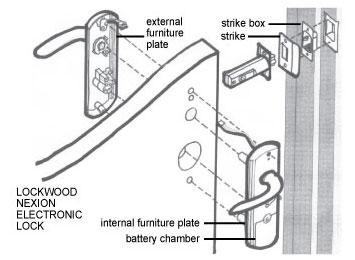
There is an increasing demand for electronic locking methods in houses and a growing variety of options on offer. Broadly speaking, they fall into the following categories:
- Keypad operation
- Remote push button operation
- Proximity readers and swipe cards
- Fingerprint I.D. operation
The most important consideration (as it affects your joinery) is whether the chosen system requires permanent wiring either through the door or in the strike plate, or whether it is simply battery operated. Systems with integral wiring are expensive to install but have the advantage of being able to be connected to alarm and intercom systems. It is usually difficult to install wiring after the door is manufactured and therefore you need to forewarn the joinery before fabrication if you need special wiring installed. The advantages of electronic locks are:
- No need for conventional keys and improved security
- Remote access possible that can be linked to security & intercom systems
- Ability to change codes without requiring a locksmith or other specialist.
The major disadvantage of electronic locks is the high initial cost and their vulnerability to power supply interruptions (back up power supplies required). The fire escape capability of individual systems also needs to be assessed. Woodworkers have trained specialists who can advise on appropriate systems for particular configurations and user requirements.
DO HARDWARE REQUIREMENTS VARY ACCORDING TO THE STYLE, SWING OR NUMBER OF DOORS?
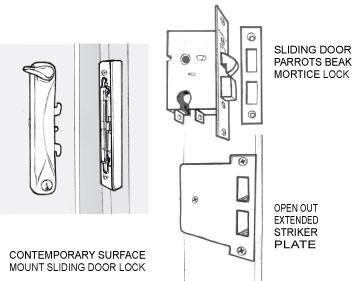
Yes. For example, pairs of doors will usually require a special rebate attachment and open out doors may need extended striker plates that differ from standard hardware. Sometimes the hardware will vary between left and right hinged joinery. With sliding or bi-folding doors or windows you may require flush fitted hardware with minimal projections if it is not to interfere with the operation of the doors or sashes adjacent. Woodworkers carry a range of flush fittings for most applications that come in finishes to complement the hanging hardware. Sliding doors will require some form of parrots beak lock or proprietory catch to suit their opening action. It is usually preferable to discuss your requirements with a Woodworkers hardware specialist to ensure you get hardware appropriate for your needs.
WHAT WARRANTY APPLIES TO HARDWARE ITEMS?
One year from the date of purchase. Woodworkers however, assumes no liability under this warranty for the following:
- Improper installtion or failure to follow fitting instructions.
- Failure due to improper maintenance or fair wear and tear.
- Indirect or consequential loss or damage, cost of removal and/or replacement.
- Cost of freight and /or travelling time.
- Any modification to a product as supplied.
All finishes may experience minor deterioration under some climatic conditions and normal everyday use, which is excluded from this warranty.
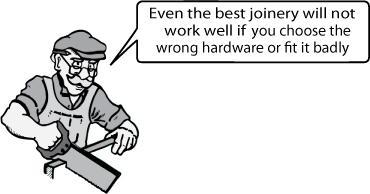
WHAT IS THE WARRANTY ON DOUBLE HUNG SPIRAL BALANCES?
Woodworkers uses Whitco Spiral Balances which are warranted by their parent Assa-Abloy Australia Pty Ltd in accordance with Australian consumer law. If spiral balances become inoperative the onus to repair or replace them rests firstly with the hardware manufacturer. If it is faulty, it is the manufacturer that warranties it, not the department store. Assa Abloy warrants its Whitco branded products to be defect free in material and workmanship including mechanical parts for 10 years from the date of purchase by Woodworkers, subject to limitation and exclusions set out in their warranty (a copy can be viewed on their website https://www.assaabloyopeningsolutions.com.au/en/about-assa-abloy/warranties-and-guarantees/).
Faulty/broken claims can be made by contacting Assa Abloy direct on
https://www.assaabloyopeningsolutions.com.au/en/contact/
Ph: 1300 LOCK UP(1300 562 587), Outside Australia: +61 3 8574 3619
Whitco spiral balances are pre-fitted to manufacturers specification according to the size and weight of each sash under factory conditions. Removal of the sash and balances on site for painting or in some cases re-glazing and then the refitting of this product by inexperienced installers is a major cause of failure due to over or under tensioning. If you feel the product has a legitimate defect, Assa Abloy will repair the problem but will invoice the work if the cause isn't covered by their warranty. Woodworkers retains responsibility to ensure the warranty claim is fairly assessed.
The Woodworkers Company sell replacement spiral balances and have a video on our website explaining the process of removing and replacing spirals but do not undertake site repair work unless defects are advised at the time of delivery. We also have independent contractors that undertake this kind of work, which you pay directly to undertake replacement or retensioning work, where replacement isn’t a warranty claim.
I ONLY WANT ONE HANDLE. WHY DO SOME OF YOUR HANDLES ONLY COME AS A BACK TO BACK PAIR?
There are 3 methods of fitting your handle to a door.
- Face fixing. This is where the handle is fixed by screws onto the door. This method allows a single handle to be fitted to the door,
- Back to back fitting. This is where the external handle is connected with a bolt through the door to the internal handle. This provides a very strong and neat fixing but means you must use 2 handles (internal and external)
- Rear fit. This is where the handle is fitted to the door by a bolt through the door. This provides the strongest fitting of the 3 options and allows for a single handle to be fitted to the door. However, because it is fixed from the rear, the bolts are viewable from the opposite side of the door, which is usually aesthetically undesirable.
Some of our handles are offset. These handles are aesthetically pleasing, however being offset causes technical difficulties when fixing to the door. Offset handles typically have the centre line of the handle at around 45 degrees from the fixing points. With such angles, large leverage forces are applied to the fixing points. These large leverage forces on face fixed offset handles is likely over time to result in the handle being pulled off the door. For this reason offset handles should be fitted either back to back or rear fix. As rear fix handles are often aesthetically undesirable from the opposite side of the door, our recommendation is that offset handles be fitted back to back and are sold as such. Handles which are NOT offset can be securely fitted by either of the 3 fixing methods because the fixing points are directly in line with the centre line of handle.
CAN STAINLESS STEEL RUST?
Yes. There are numerous forms of oxidisation and the most common form is what we know as "rust". Stainless steel can get rust on the surface but not like other metals.Any time the surface of stainless steel is disturbed (typically from cutting, abrasion, scratching or the original manufacture) a form of oxidisation rapidly occurs where chromium oxide forms on the surface.One of the properties of chromium oxide is that it is impervious to oxygen. Because oxidisation (rust) cannot occur without oxygen, rust cannot form anywhere except on the surface above the newly formed chromium oxide layer.This type of surface rust on stainless steel is known as "tea staining". It is important to understand that tea staining is only on the surface so it cannot affect the integrity of the steel and just as importantly, is easy to remove.
HOW DO I STOP TEA STAINING OF MY STAINLESS STEEL IN THE FIRST PLACE?
There are numerous things that affect the likelihood of tea staining. Firstly, you need to choose the correct hardware for your application. Some environments are particularly likely to cause tea staining in stainless steel if wrong products are used, i.e. coastal locations. Other environments will be absolutely fine with normal tea stain resistant hardware. All Woodworkers hardware has been manufactured to be world class in corrosive resistance, however, some of our hardware is more resistant than others to tea staining. The grade of stainless used is one factor in tea stain resistance. Standard 304 grade stainless steel is highly resistant to tea staining and will be suitable in most non-coastal positions but requires some occasional cleaning to maintain first class condition. 316 stainless is much more resistant to tea staining. However, choosing 316 in severe coastal positions is not a rock solid guarantee that you will not get tea staining. All the other factors for tea stain resistance need to be considered including maintenance. One of these factors is how highly polished the surface is. Highly polished surfaces improve the resistance to tea staining. Some hardware is highly polished to a mirror finish and others have a more matt or brushed look. The level of finishing is purely aesthetic. The less shiny the finish, the less tea stain resistance the item will have. If you are not in a coastal position, typically a brushed type finish in 304 will be fine with some occasional cleaning. Maintenance is a major factor in preventing tea staining. For example, using 304 grade stainless steel that is regularly cleaned (even in marine conditions), will often out perform 316 stainless in the same article that is not cleaned. This cleaning can be as simple as firmly wiping the product with a damp cloth occasionally. The level of exposure to the elements is another major factor in the incidence of tea staining. Stainless steel outside, fully exposed to the elements, will be more resistant to tea staining than exactly the same piece of stainless that is moderately protected by awnings or eaves. This is because cleaning is such an important factor in preventing tea staining. Surprisingly, the simple fact of rainwater periodically washing the stainless steel significantly reduces tea staining.
HOW DO I REMOVE TEA STAINING FROM MY STAINLESS STEEL?
If you do find tea staining on your stainless steel, it can only be on the surface so removal is surprisingly simple. Typically most tea staining will be easily removed by applying Inox or another brand of tea stain remover and firmly rubbing with a cloth. For more stubborn tea staining, apply Inox and leave for 5 or 10 minutes, then firmly rub with a cloth.
Never use steel wool to remove tea staining. It will produce dramatically fast removal of tea staining but at the cost of forcing carbon fibres into stainless steel, resulting in carbon rust later on.
CARE OF POWDER COATED SURFACES
The effects of ultra violet light, pollution, dirt, grime and salt deposits can all accumulate on your powder coated surface over time. To extend the effective life of powder coatings and protect any warranty requirements that may exist, a very simple regular maintenance program should be implemented for the removal of any residues. As a general rule, cleaning should take place every six months. However, in areas where pollutants are more prevalent, especially in coastal or industrial regions, a cleaning program should be carried out on a more frequent basis (i.e. every three months). To clean your powder coated surface:
- Carefully remove any loose deposits with a wet sponge.
- Use a soft brush (non abrasive) or cloth, and a mild household detergent solution to remove dust, salt and other deposits.
- Rinse off with clean fresh water.
Detergents that recommend the use of gloves when handling should be avoided as this is a good indication that the detergent is harsh and, therefore, unsuitable for cleaning your powder coating. Although some strong solvents are recommended for removing sealants or other building residues, these may be harmful to the extended life of the powder coated surface and should also be avoided as the damage may not be visible immediately and may take up to twelve months to appear. If paint splashes, sealants or other residue need to be removed, then either Methylated Spirits, Turpentine, or White Spirits may be used safely.
HANDING
When doors are hung, the side on which the doors are hinged can affect the lock or the components of the lock. This is because some hardware cannot be flipped over or reversed. For this reason some hardware has left and right versions. This is referred to as the "handing". Sometimes whether the door is inward or outward opening also affects whether left or right hardware is required.

Item1
Rebate kit RH

Item2
Rebate kit LH

Item3
Extended strike RH

Item4
Extended strike LH

Item5
Latch lock Size 1

Item6
Latch lock Size 2

Item7
Roller lock Size 2
HANDING IS ALWAYS VIEWED FROM OUTSIDE, FIRST OPENING DOOR (ACTIVE DOOR). LOCK FITTED TO ACTIVE DOOR.
| Lock size 1 | Inward Opening | Outward Opening |
| Active door hinged on left | Item 2 | Item 1 |
| Active door hinged on right | Item 1 | Item 2 |
| Lock size 2 | Inward Opening | Outward Opening |
| Active door hinged on left | Item 4 | Item 3 |
| Active door hinged on right | Item 3 | Item 4 |
DUE TO THICKNESS OF DOOR (50mm) VISTA & PIVOT DOOR (45mm) REQUIRE EITHER'
- 80mm cylinder with standard escutcheons
- 65mm cylinder with thin escutcheons
Pivot doors fitted with standard pivot kit REQUIRE NO HANDING
Pivot doors & Bifolds fitted with roller lock or size 2 latch lock DO REQUIRE HANDING
Size 1 rebated locks DO REQUIRE HANDING
Latch lock size 1
Available in 60mm backset which suits stiles above 105mm and 45mm backset to suit stiles down to 85mm.
- Cottage lever on slim plate (SILVER or PVD GOLD)
- Heritage euro lever on plate
- Handing required on rebated doors.
Jackson locks available in 60mm backset, 46mm backset and 30mm backset. 30mm backset suit down to 70mm stiles. Only cottage on slim suitable.
Latch lock size 2
Available in 60mm backset which suits stiles above 105mm and 45mm backset to suit stiles down to 85mm.
- Cottage lever on traditional plate (SILVER, PVD GOLD, BLACK)
- Levers on rose
- Handing required on pivot and bifold doors
- Size 2 lock available in black(Jackson long lock 60mm or 46mm backset in matt black)
- Size 2 rebate kit are available in black
- Size 2 extended strike not available in black
Roller lock size 2
- Handing required on pivot and bifold doors.
- Size ‘2’ roller available in black - 60mm backset
- Size ‘2’ rebate kit available in black
- Size 2 extended strike not available in black
- Tradco roller lock in MB available in 45mm backset. Handing required on rebated doors.
SIZE 1 & 2 ARE DEADLOCKS. FITTING DOUBLE CYLINDER WILL MEET INSURANCE REQUIREMENTS.
 My Account
My Account My Wishlist
My Wishlist My Enquiries
My Enquiries